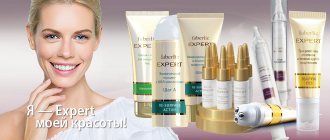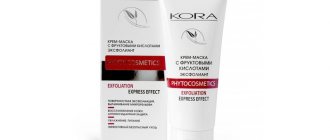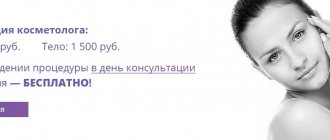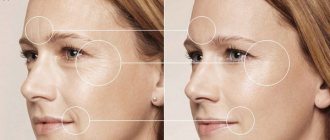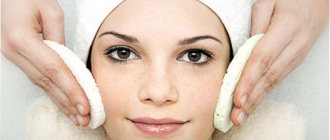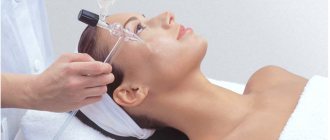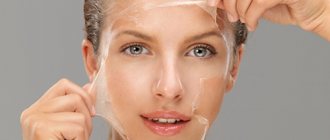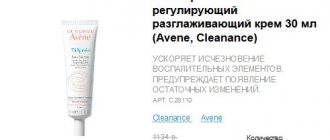Superficial chemical peels can be performed on any area of the skin. Peeling is most often performed on the face, neck, décolleté and hands. The procedure for superficial ANA peeling is quite simple and does not present any difficulties for an experienced dermatocosmetologist. At the same time, the results of peeling and the risk of developing various complications largely depend on the correct selection of patients, correct preparation of the skin in the area of intended peeling, the correct choice of concentration and pH of the acid, the time of its exposure, the duration and frequency of treatment courses.
Examination of patients and choice of treatment tactics
Superficial ANA peeling is indicated for patients with any skin type.
During the initial examination of the patient, it is necessary to pay attention to the predominance of one of the types of aging, the presence of hyperpigmentation, foci of inflammation in the peeling area, signs of herpetic lesions, the state of skin turgor and elasticity, and the degree of its hydration. Particular attention should be paid to the severity of cosmetic defects. It is necessary to find out from the patient what result he expects from the treatment and whether he overestimates the capabilities of the method.
The type of skin aging and its initial condition influence the choice of acid concentration and pH, duration of exposure, and pre-procedural preparation. If there are gross cosmetic defects (deep wrinkles and folds), the patient should be warned that they cannot be corrected using this procedure. In the case of severe actinic or senile keratosis, the patient should be informed of the need for long-term treatment and the possible use of more radical resurfacing methods (trichloroacetic acid peeling, laser peeling). It is necessary to inform the patient that in order to achieve a good cosmetic effect and maintain it, procedures must be repeated periodically over many years.
The effectiveness of peeling largely depends on the acid exposure time. The longer the acid remains on the surface of the skin, the deeper its penetration. The contact time of the acid with the patient's skin varies widely. For example, peeling time with 50% glycolic acid is usually 1-2 minutes. However, peeling can last 4-5 minutes if the initial condition of the skin requires deeper penetration and the patient tolerates the drug well. Disorders such as actinic keratoses, deep wrinkles, acne, and melasma are classic indications for longer-term treatment with glycolic acid. Why is it so important to choose the right time of acid exposure for each patient? Superficial peeling with glycolic acid is a fairly gentle procedure that does not lead to obvious disorders of the epidermis.
While undergoing treatment with glycolic acid, the patient does not retire from active life, which is a big advantage of this procedure. In case of excessively long exposure, the acid may penetrate too deeply into the epidermis (the so-called mid-peeling) and, as a result, the formation of a superficial crust. A conflict situation in this case is inevitable. In addition, too deep penetration of acid can lead to swelling of the basement membrane and activation of melanocyte function. The result of such exposure is almost always local hyperpigmentation.
Regarding AHA concentration, our experience shows:
the best effect is achieved when using 50% (pH 1.8) and 70% (pH 1.6) acid. However, the use of lower concentrations is also justified, especially at the stage of mastering the technique and to determine the sensitivity of the patient’s skin to glycolic acid.
Pre-procedural preparation
To achieve the best effect
To prevent peeling and reduce the risk of possible side effects, it is recommended to prepare the skin in advance. For pre-procedural preparation, glycolic acid preparations are used with a concentration of 8-30% and pH>2. The choice of acid concentration used at home depends on skin type, the presence of hyperpigmentation foci, type of aging, and the area where peeling will be performed.
Home preparation
consists of daily application of acid to the skin in the area of intended peeling. The use of acid is always preceded by thorough cleansing of the skin. Most lines of chemical peeling products presented in Russia contain a special skin cleanser. After washing off the acid, patients are advised to use antioxidant compositions.
Duration of home preparation
depends on the initial condition of the patient’s skin and type of aging and can last 1-4 weeks. Home preparation increases the skin's tolerance to acid and thereby allows for a more intense effect on the skin during the peeling procedure. A decrease in the degree of keratinocyte adhesion promotes more intense and deeper penetration of acid, which is necessary in some conditions. In addition, preliminary use of weak acid solutions makes it possible to timely identify rare cases of allergic intolerance to one of the components of the peeling preparation.
Comparison
Milk and almond peels are chemical acid peels and have a superficial effect . They have the same effect: moisturizing, keratolytic, cleansing, smoothing, whitening, tightening, anti-inflammatory, antibacterial.
The difference is that different acids are used for the procedures - lactic or mandelic. They are suitable for all skin types, including hypersensitive ones. These types of exfoliation can be carried out at any time of the year, the main thing is not to expose the affected area to sunlight and take good care of it.
Both methods have their contraindications:
| Lactic | Almond |
| Individual intolerance to the components included in the drug. Herpes is in the acute stage. Inflammatory processes in the acute stage. Wounds, abrasions, cracks on the face. Recent facial hair removal. Recent visit to a solarium. The presence of spider veins and dilated capillaries on the face. Colds, flu, ARVI. Oncological diseases. Diabetes. Taking medications that increase the photosensitivity of the skin. Pregnancy and lactation. | Individual intolerance to the components included in the drug. Inflammations, wounds, abrasions, pustules on the face. Herpes is in the acute stage. Recent use of a solarium or prolonged exposure to ultraviolet rays. Colds, flu, ARVI. Increased body temperature. Taking medications that increase the photosensitivity of the skin. Pregnancy and lactation. |
Basic principles of superficial AHA peeling
For superficial chemical peeling, glycolic acid is used in a concentration of 25-70% and with a pH of 1.6-1.0. The choice of acid concentration is determined by many factors. One of the main ones is the type of skin aging. For photoaging, long-term (10-15 sessions) regular peelings with 25-30% acid are recommended. For biological aging, the use of 2-3 annual courses consisting of 4-5 sessions is justified.
Peeling includes several stages, the sequential and careful implementation of which determines the success of the procedure:
- cleaning and degreasing the skin;
- applying acid to the skin (peeling);
- acid neutralization;
- post-peeling care.
The peeling procedure begins with thorough cleansing of the skin.
For this purpose, you can use 70% alcohol or special solutions. Do not treat the skin with soap, as this will lead to excessive alkalization of the skin and reduce the effectiveness of peeling. After rinsing off the cleanser and drying thoroughly, the acid is applied to the skin with quick and precise movements.
The solution should be applied in an even layer, which ensures uniform penetration of the acid throughout the treated area. Treatment is carried out in the following sequence: forehead, temples, chin, neck. The central part of the face and eyelids are processed last. On the eyelids, the acid is applied to the border with the eyelashes. Glycolic acid is not harmful to the eyes, but you should always have a container of water nearby during the peel so that you can quickly rinse your eyes if glycolic acid gets into them. After applying the acid, the specialist must remain with the patient at all times.
Accurate timing of the procedure, assessment of the patient’s sensations and skin reactions are carried out.
Even in the case of normal tolerance to glycolic acid, the patient feels a moderate burning sensation, but it should not be intolerable. The patient's statement “it stings like nettles” is an indication for immediate neutralization of the acid. The most important objective sign that determines exposure time is erythema. When the first signs of mild diffuse erythema appear, the acid should be neutralized immediately. If necessary, after neutralization in more problematic areas (keratomas, deep wrinkles), repeated peeling is allowed to achieve local, more pronounced erythema. When correcting cosmetic defects caused by photoaging or the presence of focal hyperpigmentation in a patient, the acid is neutralized immediately after the onset of diffuse erythema. With the biological type of aging, a longer exposure to acid is indicated, sometimes before the onset of a spot effect of frost.
After the exposure time has expired, it is necessary to completely remove the acid from the surface of the skin.
Simply rinsing with water does not ensure complete removal: several hours after the procedure, acid residues can penetrate into the reticular dermis and cause a 1st degree chemical burn. Therefore, neutralization is an important and very important stage of the peeling procedure. It is carried out in three stages. First, remove the main amount of the drug using a sponge soaked in water. Then a neutralizer is applied, which stops the peeling completely. Finally, the remaining glycolic acid and neutralizer are thoroughly washed off with water.
The procedure ends with the application of a special post-peeling cream, which softens the skin and eliminates the feeling of tightness.
The cream must include antioxidants. On sunny days, you should use sunscreen. Afterwards, it is recommended to wash your face with cool water and a soap-free cleanser. In the next 2-3 days after the procedure in the clinic, the patient should not use creams containing fruit acids at home, since their use can lead to deeper undesirable skin reactions.
What is this type of peeling?
Almond peeling is one of the cleansing procedures of a chemical burn, affecting only the upper layer of the epidermis, due to the peculiar structure of the molecules of the composition. The basis of the procedure is mandelic fruit acid, obtained from almonds. Mandelic acid molecules are larger in size and, by definition, penetrate the skin slowly and only superficially, and, therefore, do not act aggressively on the epidermis.
Is it safe to regularly use superficial AHA peels?
All cells have a genetically programmed limit on the possible number of mitoses, and their proliferative potential is inversely proportional to the age of the organism. And then the question arises: can we indefinitely stimulate basal keratinocytes and fibroblasts to accelerate proliferation? Will long-term chronic exposure to acid on the skin lead to decompensation of the mitotic activity of skin cellular elements? Will forced external stimulation of mitosis cause the appearance of atypical cells?
Many years of clinical experience with superficial chemical peels do not support this theory. Mild chronic exposure of the skin to organic acids does not lead to atypia or decompensation of the proliferative potential of the cellular elements of the dermis and epidermis. On the contrary, the earlier the patient began to use AHA superficial peeling, the better the effect of preventing skin aging. In the older age group (45 years or more), the cell response to peeling is more sluggish. However, with chronic use over a long period of time, there is a visible improvement in the surface of the skin and its texture.

